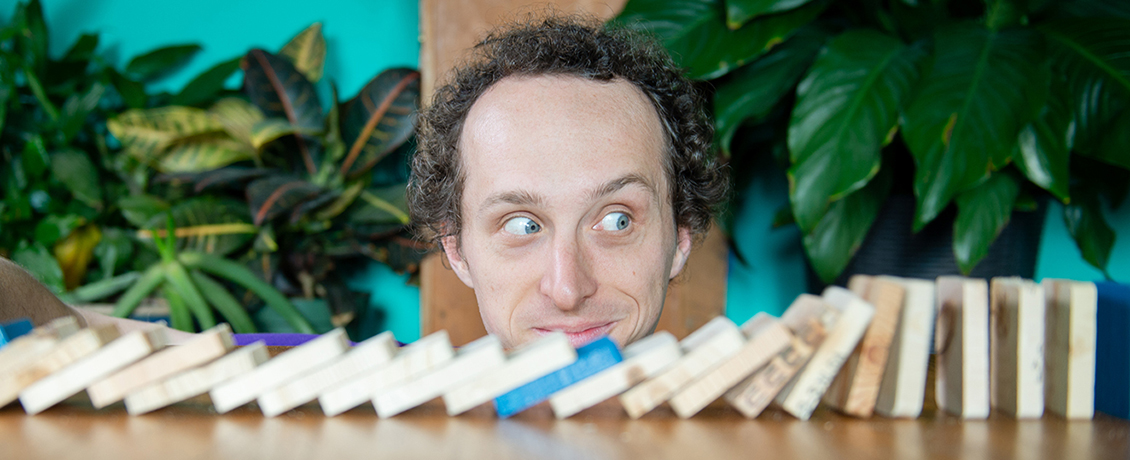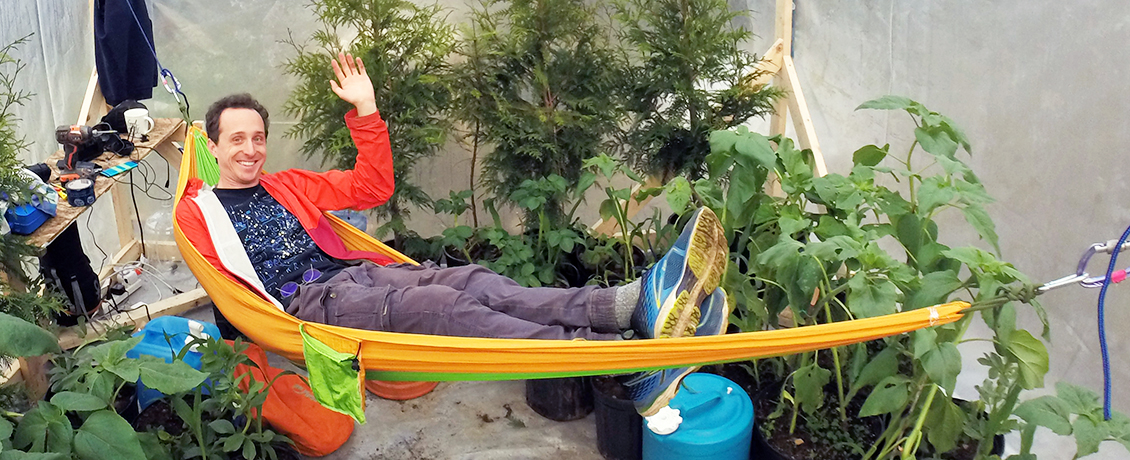Photography by Jana Josue Maclaren
More than 163,000 YouTube subscribers, over-the-top science experiments and advice about how to reduce waste, fight climate change and protect the Earth. Laurier graduate Kurtis Baute is using his science communication skills to help create a better future.
"I think that in order to take on big issues like climate change the world needs to be more science literate,” says Baute. “That’s why I do things like seal myself in a DIY biodome to talk about how we interact with the atmosphere, or measure the Earth with just my bike and two sticks."
Laurier Campus magazine caught up with the Vancouver-based Baute to discuss his career as a science communicator and his popular YouTube channel.
JZ: Your YouTube channel contains some fascinating and fun science videos. What was the motivation behind starting the channel?
KB: Ultimately, I think we have a science literacy crisis. We've got a really big problem with people not understanding even the basics of any scientific issue, whether it's climate change, vaccines, or most anything. For me, it's not only that people need to understand more about science, but also that science fundamentally changes how you see the world. When I was at Laurier, I started as a Communications Studies major and decided to take some science courses just for fun. I took Biology 101 to see what it was like and it blew my mind. I discovered that science was a way of seeing the world and it was remarkable how much value it added to my day-to-day life. I thought, "People need to know this, people need to be able to see the world like this." I started making science videos shortly after that.
JZ: So you eventually switched from Communications Studies to Biology?
KB: Midway through the semester I started taking Biology 101, I started thinking, "Could I really switch into Biology?" In my third year I finally did that. I would have never guessed in high school that I would even be interested in science, let alone today have a master of science and be doing science communications for a living.

JZ: Videos you have created have garnered more than 7.8 million views. Does that make you feel like your message is resonating?
KB: For sure. It's kind of hard to wrap my head around, honestly, but it's great. It's been a dream to reach people about science issues that matter.
JZ: How did you reach the decision to become a professional YouTuber teaching people about science?
KB: That's a good question. I've been making videos on YouTube since 2007, since the platform started, but I didn't take it seriously until two years ago when I was working as a science teacher in Vancouver. By that point, I had won some awards and even a science communication trip to Germany for my videos. It had been going well, but I had never really thought of it as a career possibility. Then, one day, I had a video that did very, very well. It had 100,000 views out of nowhere and I thought, "What if I actually put some time into this and committed myself to it?" So with 246 subscribers I went on a journey to try and make it a full-time endeavour.
JZ: What videos or initiatives have grown your subscriber base the most?
KB: Something that I don't really like about YouTube is that controversial topics tend to do much better and sometimes YouTube can actually help create controversial topics in the first place. For example, there is a flat Earth movement, which is made up of people who don't believe the Earth is a sphere. That largely came out of conspiracy theorists on YouTube. So a while ago I made a video. I wanted to repeat and show an old experiment that represented the first time people explored proving the Earth was round and measured the size of the Earth 2,000 years ago. So I made a video where I biked across Saskatchewan with two sun dials. Using some simple math, some simple algebra, along with the sun dials, I could show the size of the Earth and show that it is a sphere. That video has over 2.5 million views, which is wild. I didn't really know what would come of it and it definitely surpassed my expectations.
JZ: Among all of your videos, do you have a personal favourite?
KB: I made a video about the history of the universe using 13,799 dominos. That was the first video I was really serious about on the channel. Whether or not it's the best video, I don't know, but it is by far the one that illustrates my perspective about science, about the history of the universe and about the beauty of the world we live in. In the video, I set up a 300-metre long row of dominos, with each domino representing one million years, from the Big Bang to modern day.
By the time the Earth is even formed we are already two-thirds of the way through the dominos and the dinosaurs leave in the last 10 metres. It's just the last three dominos that represent all of human history. And if you took sandpaper to the last domino it would erase more than all of modern civilization. I think it's hard for humans to wrap their heads around that sort of scale and that sort of timeframe. Our short lives feel like that's all there is, but it's just an instant. And that's kind of beautiful.
JZ: For those not yet familiar, who is Sir Stabbington?
KB: Sir Stabbington is a cactus that I've had for the past two years. Whenever someone subscribes to the YouTube channel, he gets watered with a single drop of water through an electrical contraption I built. For the past two years that's all that's been watering him, so I've been kind of holding him for ransom. And he hasn't died, so it's good. One time I had a guest video out on a really large YouTube channel and it was the first time I got a lot of exposure on the platform. There were so many people subscribing to my channel that water from the system flooded my desk. It was the "great flood of YouTube subscribers," which is the best possible problem I could have had.

JZ: You chose to remove ads from your YouTube channel. Why?
KB: My channel is partly about science and also about the environment. When you watch YouTube ads, most of the things they are advertising for are things that people don't need. They are things that have a large environmental footprint both in terms of the carbon dioxide they emit to create and ship, as well as in terms of the plastic waste they create. My goal on YouTube is not to make a lot of money. My goal on YouTube is to spread the word about science and the environment. So I removed YouTube ads so I wouldn't proliferate that problem. It's not something everybody has the privilege to be able to do, but I have a number of wonderful patrons on the web platform Patreon and I sometimes get YouTube sponsorships that my values do align with. It takes a little more work, but it's important to me and my overall mission.
JZ: You talk about issues that couldn't be more serious. How do you stay positive?
KB: I did a project where I sealed myself in a jar to talk about climate change and I spent months talking about climate change during interviews almost non-stop after that. Honestly, it made me fairly depressed thinking about the problem all of the time, feeling helpless. Because the state of the world in a lot of ways is dire. We really need to take more action immediately and we don't seem to be doing that. But the way that I stay positive is by doing something. The reason I make a lot of these videos is largely for me. It feels good to know that at the very least, at the end of the day, I tried my best to share this important message. And if you share a message with people that's positive, it's more likely to stick. We hear a lot of tragic and depressing news and that doesn't cause people to act. But when you hear the story of Greta Thunberg, for example, just by the simple act of taking some time off on Fridays and sitting outside with a sign, she has changed the world. That is a positive story and it’s led millions of people to go out and protest over climate change. Positive stories do work and, ultimately, these are problems we can solve.
JZ: What are simple things people can do to have a positive impact on the environment?
KB: The No. 1 thing that we need to do is have system change for climate action. What that means is we first and foremost need to be electing politicians who really care about this issue. Because, frankly, we're not going to get there by people flying less or by people driving less. We need to have really major changes. Climate change affects everything. We are going to have a major health crisis if we don't take action; we will have food shortages. There are other things you can do, but this is the biggest and it often takes a backseat.
JZ: How did your Laurier experience prepare you for your career as an environmental and science communicator?
KB: I had a lot of incredible professors at Laurier. Two of the big benefits of attending Laurier – especially the Biology department – is that it's a small school where you can get to know your professors, which is amazing. And a lot of them care a lot about their students. Since they have personal interactions with their students they spend a lot of time on their lectures and they really care. There are a number of professors that stand out; their passion was evident. I remember walking away from the first day of a plant biology course being so excited. I got out of the class and called my brother telling him how cool the course was and that I had no idea how exciting science could be. It definitely filled me with a passion for science. I had no idea people in science could blow people's minds like that and it quickly became something I wanted to do.